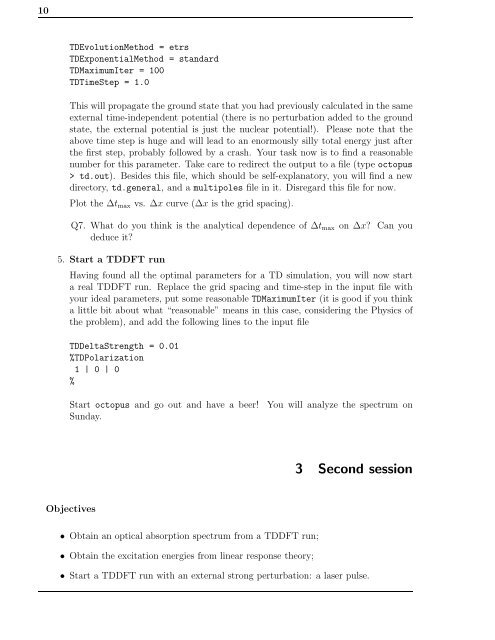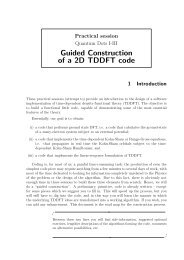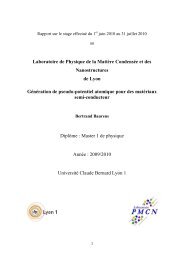Introduction to the octopus code - TDDFT.org
Introduction to the octopus code - TDDFT.org
Introduction to the octopus code - TDDFT.org
Create successful ePaper yourself
Turn your PDF publications into a flip-book with our unique Google optimized e-Paper software.
10<br />
TDEvolutionMethod = etrs<br />
TDExponentialMethod = standard<br />
TDMaximumIter = 100<br />
TDTimeStep = 1.0<br />
This will propagate <strong>the</strong> ground state that you had previously calculated in <strong>the</strong> same<br />
external time-independent potential (<strong>the</strong>re is no perturbation added <strong>to</strong> <strong>the</strong> ground<br />
state, <strong>the</strong> external potential is just <strong>the</strong> nuclear potential!). Please note that <strong>the</strong><br />
above time step is huge and will lead <strong>to</strong> an enormously silly <strong>to</strong>tal energy just after<br />
<strong>the</strong> first step, probably followed by a crash. Your task now is <strong>to</strong> find a reasonable<br />
number for this parameter. Take care <strong>to</strong> redirect <strong>the</strong> output <strong>to</strong> a file (type oc<strong>to</strong>pus<br />
> td.out). Besides this file, which should be self-explana<strong>to</strong>ry, you will find a new<br />
direc<strong>to</strong>ry, td.general, and a multipoles file in it. Disregard this file for now.<br />
Plot <strong>the</strong> ∆t max vs. ∆x curve (∆x is <strong>the</strong> grid spacing).<br />
Q7. What do you think is <strong>the</strong> analytical dependence of ∆t max on ∆x Can you<br />
deduce it<br />
5. Start a <strong>TDDFT</strong> run<br />
Having found all <strong>the</strong> optimal parameters for a TD simulation, you will now start<br />
a real <strong>TDDFT</strong> run. Replace <strong>the</strong> grid spacing and time-step in <strong>the</strong> input file with<br />
your ideal parameters, put some reasonable TDMaximumIter (it is good if you think<br />
a little bit about what “reasonable” means in this case, considering <strong>the</strong> Physics of<br />
<strong>the</strong> problem), and add <strong>the</strong> following lines <strong>to</strong> <strong>the</strong> input file<br />
TDDeltaStrength = 0.01<br />
%TDPolarization<br />
1 | 0 | 0<br />
%<br />
Start oc<strong>to</strong>pus and go out and have a beer! You will analyze <strong>the</strong> spectrum on<br />
Sunday.<br />
3 Second session<br />
Objectives<br />
• Obtain an optical absorption spectrum from a <strong>TDDFT</strong> run;<br />
• Obtain <strong>the</strong> excitation energies from linear response <strong>the</strong>ory;<br />
• Start a <strong>TDDFT</strong> run with an external strong perturbation: a laser pulse.















